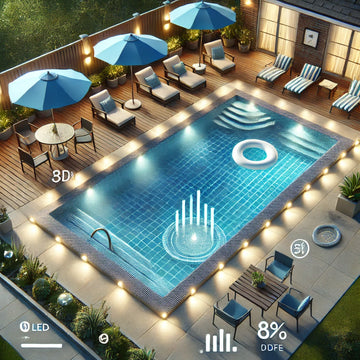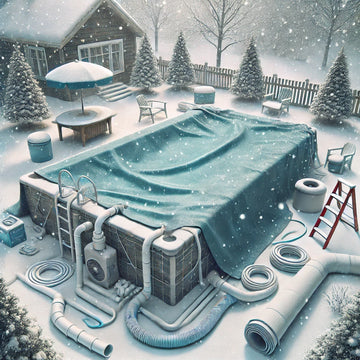A Guide to Opening Your Pool in Time for the Warm Weather
You and your pool have made it through yet another frigid Canadian winter, and the time has come to lift off the pool cover and “de-winterize” it for another season of enjoyment.
But getting your pool ready for summer involves so much more than just taking off the cover and readjusting your pool chemicals.
To help you prep your pool so it’s sparkling clean and ready to use come the first warm days of summer, read on to learn the steps to a successful pool opening.
When Should You Open Your Pool?
Weather permitting, the earlier the better. You’ll want to open your pool as soon as the ice has melted since this facilitates the opening process and makes the transition easier. Early to late spring is the ideal time (depending on the weather, of course) because it’s typically just warm enough to allow you to run the pump for just a few hours rather than all day if it’s too cold out. If you open your pool in spring, your pool will be ready to use come the first warm days of the pool season. But if you wait too long to open your pool, the warm untreated water will become hospitable for algae blooms to grow.
So to prevent algae growth and extend your pool season, aim to open your pool in (Early) late spring, just before summer starts. Many pool owners in Canada choose to open their pools during the long weekend in May.
How To “De-Winterize” Your Pool
Follow these steps to open your pool and have it ready to use in time for the warm weather.
Remove Any Debris
Before you open your pool, clean the cover and the area around the pool, including the pool deck. Remove debris that may have flown into your yard over the winter, clean up leaves and twigs, and trim any overhanging branches that could drop foliage into your pool.
Drain and/or Remove Winter Pool Cover and Clean It for Storage
For tarp covers (not recommended): Before removing your winter pool cover, drain any water from rain or melted ice and snow from the top, so it doesn’t pour into your pool. Use a cover pump or a wet-dry shop vac to remove as much water as possible from the cover. And gently sweep or blow off any leaves or other debris that has accumulated on the cover.
For safety covers: Safety covers allow the water to go directly back in the pool, so there is no need to drain or remove any water, as soon as the snow or ice has melted, gently sweep or blow off any leaves or other debris that has accumulated on the cover.
Once you remove the pool cover, lay it out on the ground, brush away any stuck-on debris with a soft-bristle brush, and rinse off the cover with a hose. Allow the cover to air dry completely before storing it. You can also sprinkle talcum powder on the dry cover to prevent mould and mildew growth.
When ready to store, fold up the cover loosely and store in a cool, dry place.
Remove Winter Plugs and Re-Attach Drain Plugs
Remove the winterizing protection tarp or cover from your pool equipment, such as the filter, pump, booster pump, heater, and pool cleaners. And re-attach the regular drain plugs for the pool season.
Remove Winterizing Plugs from Skimmer and Return Lines
Remove the winterizing plugs—or Gizmo or Skimmer Guard—from the skimmer and return lines. If you added antifreeze to your skimmer during pool winterization, you’ll also need to remove the antifreeze. Alternatively, if you used the proper pool antifreeze, it can be pushed back in the pool.
For a cartridge filter, use a wet-dry shop vac on the skimmer line to pull out the antifreeze. And for a DE or sand filter, turn the handle of the multiport valve to “waste” to push the antifreeze to the waste line while the pump runs. Again, if the proper antifreeze was used, you can leave it and the pool can be started. without performing these steps.
Next, reconnect the return valve fittings that were removed when you winterized your pool.
Raise the Water Level Back to Normal
Aim to have the water level near the middle of the skimmer opening or halfway up the tile.
This step needs to be taken if the water level is below the skimmer. If you used a duck plug system, the water will most likely be higher than the skimmer and can be used to clean the pool or drain until the water is back to mid-skimmer level.
Part of pool winterization is lowering the water to just below the skimmer, particularly if you used a duck plug system since, as we stated, the water level will be higher.
Important tip: Despite what other pool installers may say, the water level should never naturally drop over the winter due to evaporation. If the water level does drop, that could indicate a serious problem, like a leak in the liner or the pool itself. Be sure to inspect your pool at opening to search for any signs of leaks or other damage.
Read More: Pool Leak or Evaporation?
Inspect the Filter and Pump and Reconnect Pool Equipment
Inspect the pump O-ring for cracking, and replace the O-ring if needed. If you do need to replace the O-ring, use a silicone-based lubricant before replacing the O-ring on the pump.
Once the O-ring is secure, fill the pump’s pot with water using a garden hose, put on the lid, and turn on the pump. While it’s running, look through the lid to see if the water is circulating and check the pressure on the filter pressure gauge.
If there is no movement in the water or pressure on the gauge, there might be a suction leak or pressure gauge may be broken. To remedy this, tighten the pump’s union/pipe connections and inspect the suction valves for leaks. If there are loose connections and air leaks, the pump won’t prime. And clogged or leaking suction lines will require repairs from a pool technician.
Reconnect your filter, pump, heater, and any other pool equipment you disconnected for the winter.
Turn Your System On
You can now start turning most of your pool equipment on, such as priming the pump and turning on the circulation and filtration system. Also, open the air relief valve on your filter (if you have one), so it can bleed air from the system.
Brush and Vacuum Pool
Thoroughly brush and vacuum your pool to remove any leftover dirt and debris from the winter. And make sure to pay special attention to crevices and areas near the pool steps, ladders, and other pool equipment.
Run the Filtration System
Once you’ve given your pool a thorough brushing and vacuuming, leave the filtration system running overnight. This system will help filter out any dirt, debris, algae, and bacteria left floating around in the water after scrubbing the pool.
Shock the Pool
Shock the pool to eliminate any remaining bacteria and contaminants in the water. Make sure to carefully follow the instructions on the shock product label and wear the recommended safety gear, such as goggles and gloves, when shocking your pool.
Test and Adjust Your Pool Chemistry
After running the circulation system for 24 to 48 hours, test the water’s pool chemistry and adjust as needed.
Bring a sample of your pool water to a pool store for professional testing, or use a pool test kit to check the water’s pH, Chlorine, and Total Alkalinity levels at home. The ideal range for each is as follows:
[su_list icon=”icon: tint” icon_color=”#04cee9″]- pH: 7.4 to 7.6
- Total Alkalinity: 80 to 120 ppm
- Chlorine: 2.0 to 4.0 ppm
When adjusting the pool chemistry, start with adjusting the Total Alkalinity with alkalinity increaser or decreases products. After adding the recommended amount, wait at least 4 hours before testing the water again.
Once the Total Alkalinity is in the ideal range, see if the pH has balanced out an ideal level. If not, adjust as needed, wait 4 hours, and retest the water.
Wait a day after treating the Total Alkalinity and pH before adjusting the water’s calcium hardness. The ideal level for calcium hardness is above 150 ppm.
After balancing the water chemistry, your pool should be safe, clean, and ready to use.
Hire the Experts To Open Your Pool For You
Since there are many steps to open a pool successfully after the winter, you might be more comfortable hiring the pool opening experts to do this work for you. With the help of the pros, you can be sure your pool is sparkling clean, safe, and ready to use for the first warm days of the pool season.




